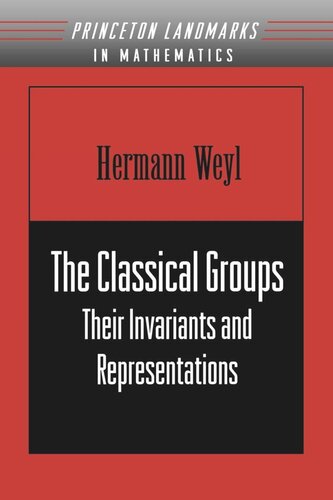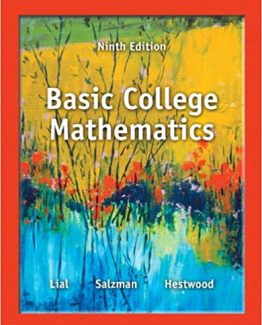The Classical Groups: Their Invariants and Representations by Hermann Weyl, ISBN-13: 978-0691057569
[PDF eBook eTextbook]
- Publisher: Princeton University Press; Reprint edition (October 13, 1997)
- Language: English
- 336 pages
- ISBN-10: 0691057567
- ISBN-13: 978-0691057569
In this renowned volume, Hermann Weyl discusses the symmetric, full linear, orthogonal, and symplectic groups and determines their different invariants and representations. Using basic concepts from algebra, he examines the various properties of the groups. Analysis and topology are used wherever appropriate. The book also covers topics such as matrix algebras, semigroups, commutators, and spinors, which are of great importance in understanding the group-theoretic structure of quantum mechanics.
Hermann Weyl was among the greatest mathematicians of the twentieth century. He made fundamental contributions to most branches of mathematics, but he is best remembered as one of the major developers of group theory, a powerful formal method for analyzing abstract and physical systems in which symmetry is present. In The Classical Groups, his most important book, Weyl provided a detailed introduction to the development of group theory, and he did it in a way that motivated and entertained his readers. Departing from most theoretical mathematics books of the time, he introduced historical events and people as well as theorems and proofs. One learned not only about the theory of invariants but also when and where they were originated, and by whom. He once said of his writing, “My work always tried to unite the truth with the beautiful, but when I had to choose one or the other, I usually chose the beautiful.”
Weyl believed in the overall unity of mathematics and that it should be integrated into other fields. He had serious interest in modern physics, especially quantum mechanics, a field to which The Classical Groups has proved important, as it has to quantum chemistry and other fields. Among the five books Weyl published with Princeton, Algebraic Theory of Numbers inaugurated the Annals of Mathematics Studies book series, a crucial and enduring foundation of Princeton’s mathematics list and the most distinguished book series in mathematics.
Table of Contents:
Title
Copyright
Dedication
TABLE OF CONTENTS
PREFACE TO THE FIRST EDITION
PREFACE TO THE SECOND EDITION
CHAPTER I INTRODUCTION
1. Fields, rings, ideals, polynomials
2. Vector space
3. Orthogonal transformations, Euclidean vector geometry
4. Groups, Klein’s Erlanger program. Quantities
5. Invariants and covariants
CHAPTER II VECTOR INVARIANTS
1. Remembrance of things past
2. The main propositions of the theory of invariants
A. FIRST MAIN THEOREM
3. First example: the symmetric group
4. Capelli’s identity
5. Reduction of the first main problem by means of Capelli’s identities
6. Second example: the unimodular group SL(n)
7. Extension theorem. Third example: the group of step transformations
8. A general method for including contravariant arguments
9. Fourth example: the orthogonal group
B. A CLOSE-UP OF THE ORTHOGONAL GROUP
10. Cayley’s rational parametrization of the orthogonal group
11. Formal orthogonal invariants
12. Arbitrary metric ground form
13. The infinitesimal standpoint
C. THB SECOND MAIN THEOREM
14. Statement of the proposition for the unimodular group
15. Capelli’s formal congruence
16. Proof of the second main theorem for the unimodular group
17. The second main theorem for the unimodular group
CHAPTER III MATRIC ALGEBRAS AND GROUP RINGS
A. THEORY OF FULLY REDUCIBLE MATRIC ALGEBRAS
1. Fundamental notions concerning matric algebras. The Schur lemma
2. Preliminaries
3. Representations of a simple algebra
4. Wedderburn’s theorem
5. The fully reducible matric algebra and its commutator algebra
B. THE RING OF A FINITE GROUP AND ITS COMMUTATOR ALGEBRA
6. Stating the problem
7. Full reducibility of the group ring
8. Formal lemmas
9. Reciprocity between group ring and commutator algebra
10. A generalization
CHAPTER IV THE SYMMETRIC GROUP AND THE FULL LINEAR GROUP
1. Representation of a finite group in an algebraically closed field
2. The Young symmetrizers. A combinatorial lemma
3. The irreducible representations of the symmetric group
4. Decomposition of tensor space
5. Quantities. Expansion
CHAPTER V THE ORTHOGONAL GROUP
A. THE ENVELOPING ALGEBRA AND THE ORTHOGONAL IDJIAL
1. Vector invariants of the unimodular group again
2. The enveloping algebra of the orthogonal group
3. Giving the result its formal setting
4. The orthogonal prime ideal
5. An abstract algebra related to the orthogonal group
B. THE IRREDUCIBLE REPRESENTATIONS
6. Decomposition by the trace operation
7. The irreducible representations of the full orthogonal group
C. THE PROPER ORTHOGONAL GROUP
8. Clifford’s theorem
9. Representations of the proper orthogonal group
CHAPTER VI THE SYMPLECTIC GROUP
1. Vector invariants of the symplectic group
2. Parametrization and unitary restriction
3. Embedding algebra and representations of the symplectic group
CHAPTER VII CHARACTERS
1. Preliminaries about unitary transformations
2. Character for symmetrization or alternation alone
3. Averaging over a group
4. The volume element of the unitary group
5. Computation of the characters
6. The characters of GL(n). Enumeration of covariants
7. A purely algebraic approach
8. Characters of the symplectic group
9. Characters of the orthogonal group
10. Decomposition and ×-multiplication
11. The Poincaré polynomial
CHAPTER VIII GENERAL THEORY OF INVARIANTS
A. ALGEBRAIC PART
1. Classic invariants and invariants of quantics. Gram’s theorem
2. The symbolic method
3. The binary quadratic
4. Irrational methods
6. Side remarks
6. Hilbert’s theorem on polynomial ideals
7. Proof of the first main theorem for GL(n)
8. The adjunction argument
B. DIFFERENTIAL AND INTEGRAL METHODS
9. Group germ and Lie algebras
10. Differential equations for invariants. Absolute and relative invariants
11. The unitarian trick
12. The connectivity of the classical groups
13. Spinors
14. Finite integrity basis for invariants of compact groups
15. The first main theorem for finite groups
16. Invariant differentials and Betti numbers of a compact Lie group
CHAPTER IX MATRIC ALGEBRAS RESUMED
1. Automorphisms
2. A lemma on multiplication
3. Products of simple algebras
4. Adjunction
CHAPTER X SUPPLEMENTS
A. SUPPLEMENT TO CHAPTER II, §§9–13, AND CHAPTER VI, §1, CONCERNING INFINITESIMAL VECTOR INVARI
1. An identity for infinitesimal orthogonal invariants
2. First Main Theorem for the orthogonal group
3. The same for the symplectic group
B. SUPPLEMENT TO CHAPTER V, §3, AND CHAPTER VI, §§2 AND 3, CONCERNING THE SYMPLECTIC AND ORTHOGON
4. A proposition on full reduction
5. The symplectic ideal
6. The full and the proper orthogonal ideals
C. SUPPLEMENT TO CHAPTER VIII, §§7–8, CONCERNING.
7. A modified proof of the main theorem on invariants
D. SUPPLEMENT TO CHAPTER IX, §4, ABOUT EXTENSION OF THE GROUND FIELD
8. Effect of field extension on a division algebra
ERRATA AND ADDENDA
BIBLIOGRAPHY
SUPPLEMENTARY BIBLIOGRAPHY, MAINLY FOR THE YEARS 1940–1945
INDEX
What makes us different?
• Instant Download
• Always Competitive Pricing
• 100% Privacy
• FREE Sample Available
• 24-7 LIVE Customer Support






Reviews
There are no reviews yet.